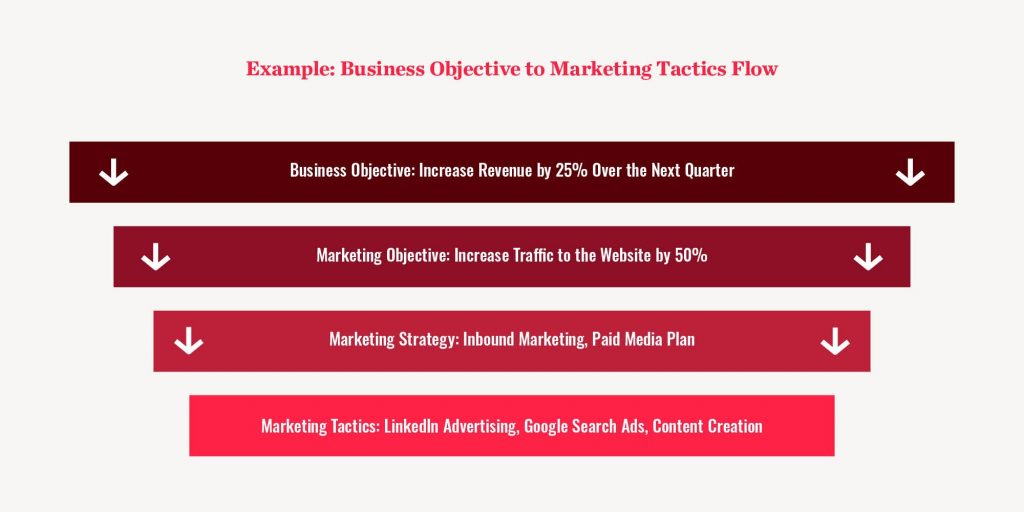Let’s start with a startling statistic—marketers who document their strategy are 313% more likely to report success than those who don’t. Clearly, having a game plan is important. So why do so many marketers (according to the same study, nearly 40%) skip this step?
My theory—the word “strategy” can feel daunting, scary, and ambiguous. What is a marketing strategy? What does it look like? And how do I know if I’m planning in the right way?
In this blog post, I’m not going to try to cover how to create a complete marketing strategy from scratch (that’s what our world famous Marketing Toolkit is for!). Instead, we’re starting with the basics and foundation of any great marketing strategy—setting marketing goals that align with your business objectives.
Getting Clear on the Lingo
One of the major communication breakdowns in marketing happens when people have a different understanding of “obvious” terms.
Here’s what I mean.
When I say “marketing strategy,” what do you think of? What about a “marketing plan?” Or a “marketing roadmap?”
Even though none of these terms are particularly difficult to understand, if I were to ask a room full of marketers to define each they’d almost certainly come up with slightly different answers. In this case, semantics do matter, so getting clear on what each term means for your business and your team will help alleviate some stress and clear up expectations.
A few basics we think are important include:
Objectives
Objectives are the major goals or milestones you set out to accomplish. They can refer to both the overall business and to marketing specifically.
Strategies and Plans
Your strategies are the comprehensive plans you will use to achieve multiple objectives. Marketing strategies and plans get mixed up all the time (so much so that I wrote a blog post about it). But think of your strategy as a high-level look at your marketing—who you’re targeting, what your niche is, etc.
Tactics
The specific methods or channels used within a strategy to reach a goal. Some common examples would be Facebook marketing, Google Ads, and email marketing.
Metrics
The statistics used to evaluate the growth or success of each tactic. A few examples include cost per click (CPC), cost per acquisition (CPA), return on investment (ROI), and more.
Again, these terms shouldn’t be anything new. But if you’re tossing around the term “marketing strategy” when actually you’re talking tactics, you can really confuse your team.
Aligning Business and Marketing Goals
One of the biggest issues marketers face is chasing a goal or number that doesn’t impact the business. This is the worst. It means that you, as the marketer, have spent tons of resources (time, money, energy) trying to move a number that didn’t actually matter. When marketing can’t prove its worth to a company, bad things happen—budgets get cut, it gets harder to get buy-in from the higher-ups, and more.
One way to ensure all this bad stuff doesn’t happen is to align your marketing objectives with your business objectives. When planning, you need to know what your business’ objectives are first. From there, you can create smaller marketing objectives that roll up to the larger task at hand.
It looks a little something like this:

Take a look at your own marketing objectives. Do they align with your business objectives? If they don’t, or there’s not a clear correlation between marketing and the bottom line, you might need to reevaluate your marketing objectives.
Setting Marketing Objectives: A Real Life Example
This all sounds great in theory, but if you’re a little lost let’s look at an example word problem (fun!).
The Problem: You’re the marketing manager for a sales consulting firm. The business objective is to increase revenue by 25% over the next quarter. What marketing objectives, strategies, and tactics could you implement to support this business goal?
It goes without saying that there are a variety of different ways you could solve this problem. And, for the sake of the example, let’s pretend that this is the correct business objective to tackle—we won’t go down the rabbit hole of asking questions like “why do we need to increase revenue?”
Step 1: Identify Marketing Objectives
Looking at the previous flowchart, we know we need to set a marketing objective that supports growing sales revenue. Maybe that’s setting a goal to increase the amount of “marketing generated revenue,” which is revenue that’s directly attributed to marketing.
This is definitely an option. Other options might include growing quality traffic to your website, improving conversion rates on important landing pages, or growing brand awareness among a specific audience.
Step 2: Create a Strategy/Plan
Once you uncover the objective, think about the strategy and plans that could make your objective a reality. This will likely include things like who you’re targeting and what marketing tactics you’ll use to reach your goal. This is also the part where you need to ask really good questions like, “how much can I spend,” “what have we done in the past,” and “what are our competitors doing?”
If your marketing objective is to increase quality site traffic because you know that will increase sales revenue, you might consider creating a paid media and inbound marketing strategy to drive a specific audience to your site.
Step 3: Set the Tactics
Finally, think through the marketing tactics that your strategy will involve, as well as the metrics you’ll need to track to prove it’s working.
In our example, this might translate to LinkedIn advertising, content creation, and Google Search ads.

An example of distilling business objectives into marketing objectives, strategies, and tactics.
Get a Clear Direction from the Get-Go
Setting marketing objectives and creating a solid plan isn’t extremely difficult, but it is one of those things that if you neglect it or get lazy, it could screw everything up.
Don’t let that happen.
Whether you’re a marketing team of one or you’re leading a group of strategists, setting marketing objectives is the first step towards cementing marketing as an integral part of your business. Get clear on what you’re trying to accomplish, document it, execute, and measure. It’s that simple.





